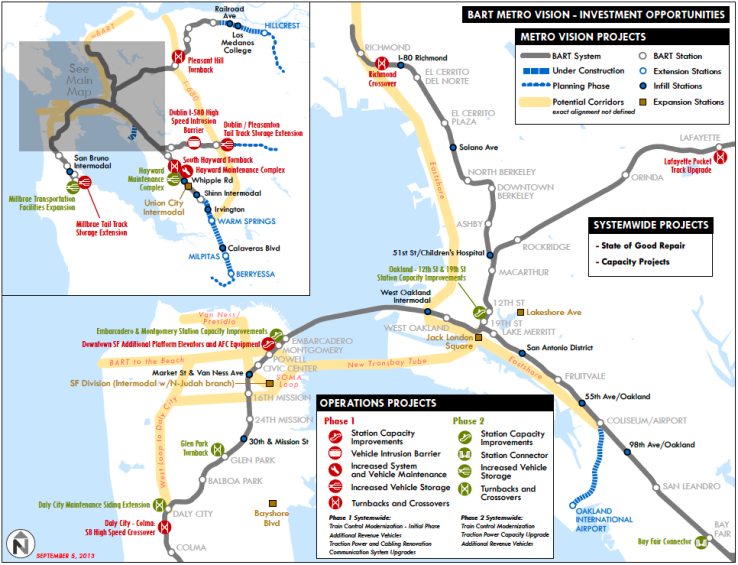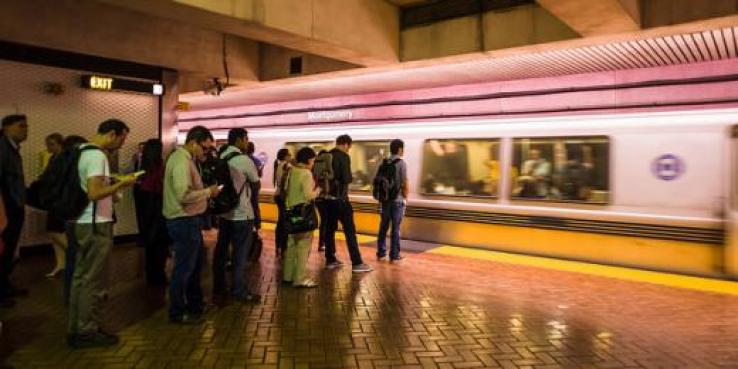As BART ridership continues to grow much faster than expected, the agency is exploring ideas big and small for increasing capacity and improving service. As we’ve written about before, the focus is on developing the “BART Metro” concept, which recognizes BART’s two roles: one as a commuter rail that delivers riders from suburbs to urban employment centers during peak hours; and the other as a metro that offers all-day, frequent service within the urban core of the Bay Area. After completing a study of near-term upgrades — “BART Metro: Sustainability Communities Operational Analysis”— the agency is now working to set long-term priorities for key investments that will shape the future of rail transit in the Bay Area.
While the earlier study looked at how to meet increases in demand expected by 2025, the study currently underway, called BART Metro Vision, looks beyond 2025, to when BART would serve more than 750,000 daily riders — almost double today’s ridership of 400,000. The Metro Vision analysis contemplates the benefits that can be derived from a broad range of major capital investments. How can BART service respond to unprecedented demand while fostering the vision for a more sustainable region? How should BART balance its needs to satisfy ridership demand with the need to maintain current operations in a state of good repair? The Metro Vision Study must provide recommendations that support BART’s two distinct yet imperative roles as a commuter rail and an urban metro while planning for the Bay Area’s changing mobility needs. Today the “urban core” is defined as San Francisco, Oakland and Berkeley, but this may change. For example, once service is extended to Silicon Valley, parts of the South Bay could evolve to constitute an "urban core" requiring metro-type service.
In the past, the underlying tension between BART’s two competing roles has been played out politically, with BART spending significant capital on outward extensions of its lines. The inclusion of the metro concept as a key component of BART’s vision for its future is a sign that BART understands the need to move away from its tradition of outward expansion and instead focus on enhancing quality of service along existing lines. See SPUR’s comparison of BART and the DC Metrorail for a glimpse into the benefits of changes such as increased service and additional stations along routes with greater ridership potential.
What Changes Could the Future BART Entail?
The Metro Vision study considers the merits of pursuing more than 100 possible investments. Among the range of possibilities are new BART lines in San Francisco, new station locations between the Oakland Coliseum and Fruitvale stops, and the possibility of a second transbay tube connecting to the East Bay at Jack London Square. Each investment has unique challenges and outstanding questions to explore. How would a new transbay tube cross the bay, and at what points would it connect San Francisco and the East Bay? What are the economic — and environmental — costs of each project? The goal is to narrow the initial set of ideas down to fewer projects with designated priorities.
Potential BART Projects Under Consideration

A number of long-term improvements to the BART system are currently under consideration. Potential projects are being evaluated first on how they help meet BART's operational goals. A cost-based evaluation will follow to determine the most economically sound options.
A major challenge for a study such as the BART Metro Vision is to devise meaningful common metrics that can be used to compare the potential of vastly different projects. For example, how can the ability of additional turnbacks and crossovers to enhance connectivity be tangibly compared with projects that focus on meeting the “last mile” gap ( i.e., getting commuters from a transit hub to their final destination)? How can proposals to widen station platforms to accommodate a growing number of riders during peak hours be compared with proposals to build new BART lines? Developing effective evaluation measures, while a great challenge, proves crucial for obtaining reliable recommendations from the study.
What Happens Next?
The formal evaluation process for narrowing down the number of future BART projects has begun. In the current, early-assessment phase of the study, the costs of the projects are not considered. The approach is to first judge projects based exclusively on the advantages they provide in the context of outlined goals. A cost-based evaluation will follow to determine the most economically sound decisions.
After a screened project list becomes ready and is presented to the BART Board of Directors, more detailed analysis of promising investments will be carried out based on collected feedback. Once the final, more viable list of projects is developed, the BART board will consider the study recommendations.
SPUR supports the BART Metro Vision Study for its pursuit of a comprehensive and objective plan for the future. We have advocated for concepts that increase BART service in the urban core for a number of years, and we recommended several of these ideas in our reports A Mid-Life Crisis for Regional Rail and the Future of Downtown San Francisco. By striving to understand the unique way in which BART serves Bay Area residents and focusing on how investments in the system can collectively move the region toward its desired vision, BART paves the path to a future we sincerely welcome.
